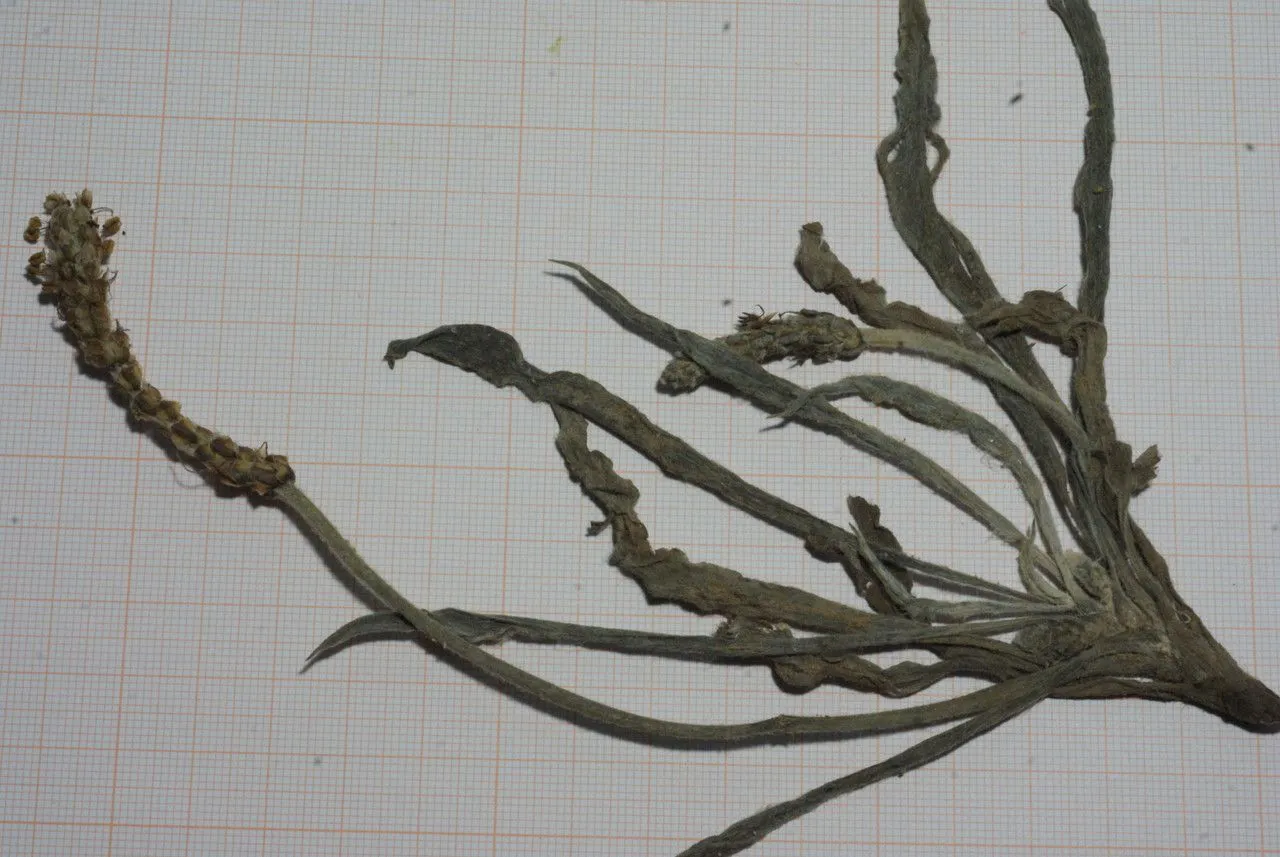
Author: L.
Bibliography: Sp. pl. 1:114. 1753
Year: 1753
Status: accepted
Rank: species
Genus: Plantago
Vegetable: False
Observations: Canary Is., Mauritania, Medit. to Iran, NE. Trop. Africa, Arabian Pen.
The Whitish plantain, known scientifically as Plantago albicans, is a perennial herb within the Plantaginaceae family. This resilient species is notably widespread, extending across various biogeographic regions including the Canary Islands, Mauritania, the Mediterranean basin, Iran, Northeastern Tropical Africa, and the Arabian Peninsula.
Plantago albicans typically thrives in arid and semi-arid environments, showcasing an impressive adaptability to diverse climatic conditions. As its common name suggests, the plant often presents a whitish hue, which can be attributed to a layer of fine, hair-like structures on its leaves that help minimize water loss—a critical adaptation for survival in its often harsh native habitats.
This species has garnered interest not only for its hardy characteristics but also for its potential applications in traditional medicine and ecological studies. Ethnobotanical records indicate that various parts of the plant have been utilized for their purported medicinal properties, including treatments for respiratory ailments and inflammation.
Ecologically, the Whitish plantain plays a significant role in its native ecosystems. It contributes to soil stabilization and provides a food source for a range of pollinating insects. Its presence in diverse regions highlights its importance in maintaining the ecological balance in these areas.
First described scientifically in 1753, with the designation ‘Plantago albicans’ in the initial volume of “Species Plantarum,” the plant was distinguished by the noted taxonomist Carl Linnaeus, often abbreviated as “L.” in botanical literature. Linnaeus’ foundational work in taxonomy has allowed for a structured understanding and classification that continues to facilitate botanical research today.
The Whitish plantain remains a subject of ongoing research, particularly in its native realms where its interactions with the environment and various uses in traditional practices continue to be explored and documented.
Spa: llanten blanco
Deu: weißlicher wegerich
Eng: whitish plantain
En: Whitish Plantain, Silvery Plantain
Ar: ينم (يَنَم)، ينمه (يَنَمه)، ينم (يِنِم)
Ca: Herba-fam
Fi: Hallavaratamo
Fr: Plantain blanchissant
De: Weißlicher Wegerich
He: לחך מלבין
It: Piantaggine biancastra
Es: Llanten blanco, Llantén blanco
: Whitish plantain
Taken Nov 30, 2019 by Miguel A. C. (cc-by-sa)
Taken Sep 7, 2022 by Macarena Marin (cc-by-sa)
Taken May 15, 2014 by Tela Botanica − Liliane Roubaudi (cc-by-sa)
Taken May 15, 2014 by Tela Botanica − Liliane Roubaudi (cc-by-sa)
Taken May 29, 2016 by Tela Botanica − Liliane ROUBAUDI (cc-by-sa)
Taken May 29, 2016 by Tela Botanica − Liliane ROUBAUDI (cc-by-sa)
Taken May 29, 2016 by Tela Botanica − Liliane ROUBAUDI (cc-by-sa)
Taken May 29, 2016 by Tela Botanica − Liliane ROUBAUDI (cc-by-sa)
Taken May 29, 2016 by Tela Botanica − Liliane ROUBAUDI (cc-by-sa)
Taken Apr 21, 2015 by Tela Botanica − Liliane Roubaudi (cc-by-sa)
© copyright of the Board of Trustees of the Royal Botanic Gardens, Kew.
© copyright of the Board of Trustees of the Royal Botanic Gardens, Kew.
Taken May 7, 2019 by Llandrich anna (cc-by-sa)
Taken Apr 1, 2021 by Llandrich anna (cc-by-sa)
Taken Apr 10, 2016 by Tela Botanica − Patrick LEBOULENGER (cc-by-sa)
Taken May 19, 2017 by Tela Botanica − Liliane ROUBAUDI (cc-by-sa)
Taken May 19, 2017 by Tela Botanica − Liliane ROUBAUDI (cc-by-sa)
Taken May 19, 2017 by Tela Botanica − Liliane ROUBAUDI (cc-by-sa)
Taken May 19, 2017 by Tela Botanica − Liliane ROUBAUDI (cc-by-sa)
Taken Sep 18, 2021 by S K (cc-by-sa)
Taken Sep 18, 2021 by S K (cc-by-sa)
Taken Sep 18, 2021 by S K (cc-by-sa)
Taken Sep 18, 2021 by S K (cc-by-sa)
Taken May 1, 2016 by Tela Botanica − Patrick LEBOULENGER (cc-by-sa)
Taken May 10, 2020 by Victor Camús (cc-by-sa)
Taken Jan 1, 1970 by Photoflora – L’Abbé COSTE (©)
Ph maximum: 8.0
Ph minimum: 7.5
Light: 8
Atmospheric humidity: 3
Bloom months: [‘apr’, ‘may’, ‘jun’, ‘jul’]
Soil nutriments: 4
Family: Myrtaceae Author: (F.Muell.) K.D.Hill & L.A.S.Johnson Bibliography: Telopea 6: 402 (1995) Year: 1995 Status:…
Family: Rubiaceae Author: Pierre ex A.Froehner Bibliography: Notizbl. Bot. Gart. Berlin-Dahlem 1: 237 (1897) Year:…
Family: Sapindaceae Author: Koidz. Bibliography: J. Coll. Sci. Imp. Univ. Tokyo 32(1): 38 (1911) Year:…
Family: Asteraceae Author: A.Gray Bibliography: Pacif. Railr. Rep.: 107 (1857) Year: 1857 Status: accepted Rank:…
Family: Fabaceae Author: Medik. Bibliography: Vorles. Churpfälz. Phys.-Ökon. Ges. 2: 398 (1787) Year: 1787 Status:…
Family: Aspleniaceae Author: (Cav.) Alston Bibliography: Bull. Misc. Inform. Kew 1932: 309 (1932) Year: 1932…